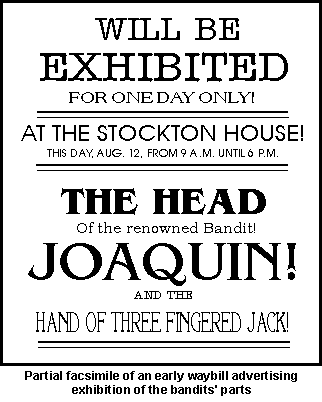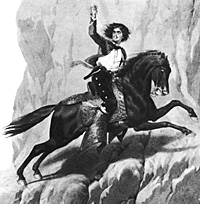 Gold Country |  Malakoff Home |

 Described by one historian a “vicious and abandoned character, low, brutal, and cruel, intrinsically and at heart a thief and a
cut-throat,” Joaquin Murieta may have been all those things. But who
was Joaquin Murieta, the man? And who was Joaquin Murieta, the legend?
Described by one historian a “vicious and abandoned character, low, brutal, and cruel, intrinsically and at heart a thief and a
cut-throat,” Joaquin Murieta may have been all those things. But who
was Joaquin Murieta, the man? And who was Joaquin Murieta, the legend? Joaquin the legend grew from a novel written by John Rollin Ridge in 1854, The Life and Adventures of Joaquin Murieta. In his book, Ridge
portrays Murieta as a folk hero, a man of “generous and noble
nature...gracefully built and active as a young tiger ...beloved by all
with whom he came in contact.” He only turned to a life of crime after American miners (choose one): beat him, tied him up, hanged his half-brother and ravished his sister. After these atrocities he declared that he would henceforth “live for revenge, and that his path should be marked with blood.” Ridge then goes on to relate of Joaquin’s daring deeds, his fearsome companions such as the notorious Three-Fingered Jack, the public outcry, the formation of Harry Love’s Mounted Rangers to hunt him down, and of Joaquin’s gruesome, bloody fate.
Joaquin the legend grew from a novel written by John Rollin Ridge in 1854, The Life and Adventures of Joaquin Murieta. In his book, Ridge
portrays Murieta as a folk hero, a man of “generous and noble
nature...gracefully built and active as a young tiger ...beloved by all
with whom he came in contact.” He only turned to a life of crime after American miners (choose one): beat him, tied him up, hanged his half-brother and ravished his sister. After these atrocities he declared that he would henceforth “live for revenge, and that his path should be marked with blood.” Ridge then goes on to relate of Joaquin’s daring deeds, his fearsome companions such as the notorious Three-Fingered Jack, the public outcry, the formation of Harry Love’s Mounted Rangers to hunt him down, and of Joaquin’s gruesome, bloody fate. But Joaquin the man was not the dashing, romantic figure that years of retelling Ridge’s story has made him out to be. When the Foreign
Miners Tax was imposed in the early 1850’s, Joaquin was forced off his
claim, as were most of the Mexican and Chinese miners in the Southern
Mines. Soon afterwards, several groups of Mexican bandits, presumably
miners dispossessed by their American counterparts, began preying upon
those who had forced them from the mines. Cattle and horses were
stolen, travelers and lone miners were robbed, beaten, and even killed.
Stores and saloons were broken into. Something had to be done to end
the reign of terror.
But Joaquin the man was not the dashing, romantic figure that years of retelling Ridge’s story has made him out to be. When the Foreign
Miners Tax was imposed in the early 1850’s, Joaquin was forced off his
claim, as were most of the Mexican and Chinese miners in the Southern
Mines. Soon afterwards, several groups of Mexican bandits, presumably
miners dispossessed by their American counterparts, began preying upon
those who had forced them from the mines. Cattle and horses were
stolen, travelers and lone miners were robbed, beaten, and even killed.
Stores and saloons were broken into. Something had to be done to end
the reign of terror.
 By piecing together various reports, it was determined that the
most notable banditos among these groups all seemed to be named
Joaquin, with surnames such as Botilleras, Ocomorenia, Valenzuela,
Carrillo, and Murieta. The State Legislature passed an act authorizing
one Harry Love to raise a company of mounted rangers in an attempt to
capture the “gang of robbers commanded by the five Joaquins.” Governor
Bigler approved the act on May 11 of 1853, and then personally posted a
$1,000 reward for any Joaquin captured or killed.
By piecing together various reports, it was determined that the
most notable banditos among these groups all seemed to be named
Joaquin, with surnames such as Botilleras, Ocomorenia, Valenzuela,
Carrillo, and Murieta. The State Legislature passed an act authorizing
one Harry Love to raise a company of mounted rangers in an attempt to
capture the “gang of robbers commanded by the five Joaquins.” Governor
Bigler approved the act on May 11 of 1853, and then personally posted a
$1,000 reward for any Joaquin captured or killed. Two months later, the rangers ran across a group of Mexicans near Panoche Pass, to the west of Tulare Lake and about one hundred miles
from the Southern Mines. Words were exchanged and rapid gunplay ensued,
resulting in the death of two Mexicans. The rangers lopped off the head
of one and stuck it in a jar of alcohol for preservation, claiming it
to be the head of Joaquin Murieta. The other body gave up a hand,
similarly preserved, which was said to have belonged to the nefarious
Three-Fingered Jack. The detached appendages were then presented to the
authorities, who despite no positive identification being possible,
proclaimed the matter settled and paid the reward. The severed “Head of
Murieta” and “Hand of Jack” then hit the road, becoming a main
attraction for many years at different locations throughout the western
states.
Two months later, the rangers ran across a group of Mexicans near Panoche Pass, to the west of Tulare Lake and about one hundred miles
from the Southern Mines. Words were exchanged and rapid gunplay ensued,
resulting in the death of two Mexicans. The rangers lopped off the head
of one and stuck it in a jar of alcohol for preservation, claiming it
to be the head of Joaquin Murieta. The other body gave up a hand,
similarly preserved, which was said to have belonged to the nefarious
Three-Fingered Jack. The detached appendages were then presented to the
authorities, who despite no positive identification being possible,
proclaimed the matter settled and paid the reward. The severed “Head of
Murieta” and “Hand of Jack” then hit the road, becoming a main
attraction for many years at different locations throughout the western
states.
 Gold Country |  Malakoff Home |